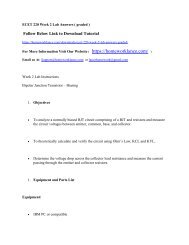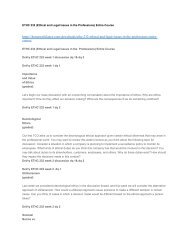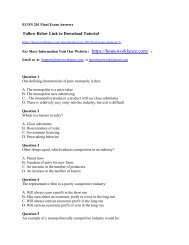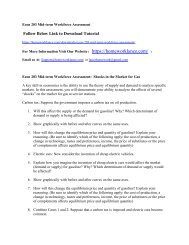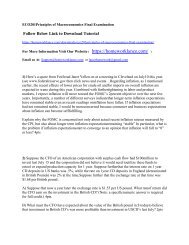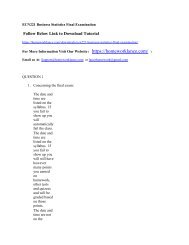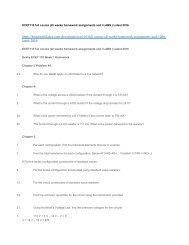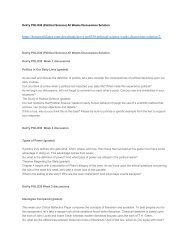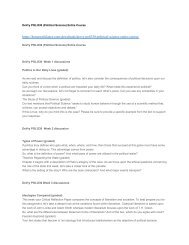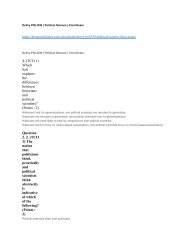ECO 550 Entire Course Managerial Economics and Globalization
Create successful ePaper yourself
Turn your PDF publications into a flip-book with our unique Google optimized e-Paper software.
<strong>ECO</strong> <strong>550</strong> <strong>Entire</strong> <strong>Course</strong> <strong>Managerial</strong> <strong>Economics</strong> <strong>and</strong> <strong>Globalization</strong><br />
Follow Below Link to Download Tutorial<br />
https://homeworklance.com/downloads/eco-<strong>550</strong>-entire-course-managerial-economics-globalization/<br />
For More Information Visit Our Website ( https://homeworklance.com/ )<br />
Email us At: Support@homeworklance.com or lancehomework@gmail.com<br />
<strong>ECO</strong> <strong>550</strong> DQ 1: <strong>Managerial</strong> Economic Decision Making<br />
From the e-Activity, assess how business leaders use managerial economics to make business<br />
decisions indicating how profits may be impacted. Analyze the principal-agent problem to<br />
determine how the relationship could be less adversarial.<br />
<strong>ECO</strong> <strong>550</strong> DQ 2: Fundamental Economic Concepts<br />
Pick a recently released good or service. Then, determine the factors that must be evaluated<br />
regarding the product’s supply <strong>and</strong> dem<strong>and</strong>. Analyze how these factors impact the decision to<br />
supply the product indicating the significance of each in the decision-making process.<br />
<strong>ECO</strong> <strong>550</strong> DQ 3<br />
From the e-Activity, explain the most important information you would require on which to base<br />
sound economic judgments. Explain your rationale. Assess the various forms of organizing <strong>and</strong><br />
processing information to determine which is the most difficult to get correct. Explain your<br />
rationale<br />
<strong>ECO</strong> <strong>550</strong> DQ 4
Analyze the characteristics that make any transaction possible <strong>and</strong> justify the importance of each<br />
of the characteristics.Evaluate the role institutions play in transactions <strong>and</strong> discuss the likely<br />
economic impact if institutions did not exist.<br />
<strong>ECO</strong> <strong>550</strong>Chapter 1 (Ex.2, 3, 4) <strong>and</strong> Chapter 2 (Ex.1, 5, 6)<br />
<strong>ECO</strong> <strong>550</strong> Chapter Questions<br />
<strong>ECO</strong> <strong>550</strong> WEEK 2<br />
DQ 1 : Dem<strong>and</strong> Analysis<br />
From the e-Activity, if you were a manager in a tobacco company, analyze the elasticity of<br />
dem<strong>and</strong> for tobacco products.<br />
DQ 2 : Estimating Dem<strong>and</strong><br />
Provide an example when it would be appropriate to conduct a time-series or cross sectional<br />
data. Discuss the potential problems that may arise with your example <strong>and</strong> identify strategies for<br />
minimizing the impact of the potential problems.<br />
DQ 3<br />
Analyze how markets work <strong>and</strong> make recommendations for or against any form of price control.<br />
Explain your rationale<br />
DQ 4
Evaluate the impact of globalization on domestic governance. Identify <strong>and</strong> explicate at least three<br />
significant factors requiring domestic changes.<br />
Chapter 1 <strong>and</strong> 2 Quiz 1<br />
Chapter Questions<br />
Week 2, Quiz 1 (Set 1)<br />
Week 2, Quiz 1 (Set 2)<br />
<strong>ECO</strong> <strong>550</strong> WEEK 3<br />
DQ 1: Business <strong>and</strong> Economic Forecasting<br />
From the e-Activity, develop a regression equation using the data you collected from your<br />
research. Use the regression equation to focus the dem<strong>and</strong> for the product you chose for the next<br />
three periods.<br />
DQ 2: Managing in the Global Economy<br />
Evaluate the relationship between the European Euro crisis in 2012 <strong>and</strong> the American economy.<br />
Assess how this affects American businesses <strong>and</strong> decisions made by mangers related to<br />
sustainable profitability.<br />
DQ 3
From the e-Activity, discuss how the company you selected should increase its competitive<br />
stance in the marketplace. Provide specific examples to support your response.<br />
DQ 4<br />
Imagine monopolizing a service or product of your choice. Discuss how you would go about<br />
setting prices for your product or service.Select a non-monopolized product or service with<br />
which you are familiar <strong>and</strong> determine how the consumption of that product or service would<br />
differ if it were controlled by a monopoly.<br />
Assignment 1 – Dem<strong>and</strong> Estimation (Two Equations)<br />
QD = – 5200 GÇô 42P + 20C + 5.2(I) + 0.20(A) + 0.25(M)QD = – 5200 – 42P + 20C + 5.2(I)<br />
+ 0.20(A) + 0.25(M)<br />
QD = 20,000 – 10P + 1500A + 5PX + 10 I)<br />
Qd = – 5200 – 42P + 20PX + 5.2I + .20A + .25M)<br />
Qd = – 5200 – 42P + 20PX + 5.2I + .20A + .25M)<br />
QD = 20,000 – 10P + 1500A + 5PX + 10 I)<br />
Chapter 3 <strong>and</strong> 4 Quiz 2<br />
Chapter 5 <strong>and</strong> 6<br />
WEEK 4<br />
DQ 1: Production <strong>Economics</strong>
From the e-Activity, determine the environmental variable most likely to affect the short-run<br />
production over the next 12 months. Determine what managers can do to prepare for the possible<br />
change in short-run production. Pick a real or fictitious business.<br />
DQ 2: Cost Analysis<br />
Pick a good or service. Distinguish between the short-run <strong>and</strong> the long-run production <strong>and</strong> cost<br />
function for that good or service. Discuss how price plays a role in short-run <strong>and</strong> the long-run<br />
decisions <strong>and</strong> how managers are likely to respond in each case.<br />
DQ 3: Describe an oligopoly company <strong>and</strong> explain what makes it so.<br />
An Oligopoly company is a company with a market dominated by a small number of participants<br />
who are able to collectively exert control over supply <strong>and</strong> market prices.<br />
DQ 4<br />
Discuss a scenario where price fixing is beneficial to all parties involved<br />
Chapter 5 <strong>and</strong> 6, Quiz 3<br />
Chapter 7 <strong>and</strong> 8<br />
WEEK 5<br />
DQ 1: Applications of Cost Theory
Imagine you are a manager of a chemical company. An accident has occurred in which<br />
chemicals leaked into the ground water nearby, the community is unaware. Assess the costs<br />
involved in cleaning up the water immediately (confessing) versus hiding the fact <strong>and</strong> possibly<br />
paying more in the future.<br />
DQ 2: Prices, Output <strong>and</strong> Strategy<br />
Pick a good or service you are familiar. Speculate how the price for that good or service may<br />
have been set <strong>and</strong> how well this price maximizes profit for the company <strong>and</strong> determine what<br />
shifts the company should made in its pricing strategy.<br />
DQ 3<br />
From the e-Activity, explicate the five competitive forces that shape strategy. Then, determine<br />
which of the five competitive forces has the most significant impact on strategy in general.<br />
DQ 4<br />
With the same small business from the first discussion in mind, describe the best possible merger<br />
or agreement to grow your company <strong>and</strong> maximize profits.<br />
Chapter 9 <strong>and</strong> 10
Chapter 8 Questions<br />
Midterm Exam<br />
WEEK 6<br />
DQ 1: Monopolies<br />
From the first e-Activity, imagine this company acting as a monopoly was to have a new<br />
competitor arrive in the marketplace. Assess how the monopoly would likely change its pricing<br />
strategy to compensate for the new competition.<br />
DQ 2 : Oligopoly<br />
From the second e-Activity, assess the marketing <strong>and</strong> pricing strategies, for example rebates, to<br />
determine the goal(s) of the marketing <strong>and</strong> pricing strategies for one of the companies you<br />
researched.<br />
DQ 3: The <strong>Economics</strong> of Contracts<br />
From the e-Activity, discuss ways that one party or the other could leverage a specific<br />
“opportunism.” Provide specific examples to support your response.Discuss a situation in which<br />
both parties entering into a contract could benefit from slightly ambiguous language contained in<br />
the contract.<br />
DQ 4: Property <strong>and</strong> Contracts
Analyze the various ways in which property rights encourage economic development <strong>and</strong> make<br />
at least one recommendation for improving current laws. Explain your rationale.Based on the<br />
possible beneficial externalities from college education, argue for whether or not a case exists for<br />
public funding of college education.<br />
Assignment 2: Operations Decisions (Two Equations)<br />
QD = 20,000 – 10P + 1500A + 5PX + 10I<br />
QD = – 5200 – 42P + 20C + 5.2(I) + 0.20(A) + 0.25(M)<br />
Chapter 8 Quiz 4<br />
Chapter 11 <strong>and</strong> 12<br />
Chapter Questions<br />
WEEK 7<br />
DQ 1: Game Theory<br />
Please respond to the following: • Dem<strong>and</strong> for airline tickets fluctuates throughout the year,<br />
which affects the price of an airline ticket. Suggest the type of game that may be most<br />
appropriate for a specific airline to play to address the differences in dem<strong>and</strong> <strong>and</strong> elasticity <strong>and</strong><br />
the resulting impact on profitability.<br />
DQ 2: Pricing Techniques<br />
From the second e-Activity, propose the new target market segment for the product <strong>and</strong> its<br />
accompanying pricing strategy (for example, bundling <strong>and</strong> couponing). Provide a rational for<br />
why you feel the new target market <strong>and</strong> pricing strategy would be successful <strong>and</strong> the likely<br />
impact to the profitability of the firm.
DQ 3<br />
Propose the new target market segment for the product <strong>and</strong> its accompanying pricing strategy<br />
(for example, bundling <strong>and</strong> couponing). Provide a rational for why you feel the new target<br />
market <strong>and</strong> pricing strategy would be successful <strong>and</strong> the likely impact to the profitability of the<br />
firm.<br />
DQ 4<br />
The pharmaceutical industry often has the luxury of implementing pricing strategies that appear<br />
high to consumers. Take a position on the fairness of the industry’s approach to pricing<br />
pharmaceutical products including offering an alternative strategy that may be more palatable to<br />
consumers.<br />
Chapter 9 <strong>and</strong> 10, Quiz 5<br />
Chapter 13 <strong>and</strong> 14<br />
Chapter Questions<br />
WEEK 8<br />
DQ 1: Contracting<br />
From the e-Activity, propose a methodology for assessing the risk in business contracts. Assess<br />
the economic impact this methodology may have for the organization.
DQ 2: Organization Form<br />
Analyze the potential downfalls of any team effort <strong>and</strong> make at least one recommendation for<br />
minimizing risk. Provide specific examples to support your response. Evaluate the organization<br />
form that would be most efficient in minimizing the principal-agent problem.<br />
DQ 3: Organization Form<br />
Analyze the potential downfalls of any team effort <strong>and</strong> make at least one recommendation for<br />
minimizing risk. Provide specific examples to support your response.<br />
DQ 4: Contracting<br />
From the e- Activity, propose a methodology for assessing the risk in business contracts. Assess<br />
the economic impact this methodology may have for the organization.<br />
Chapter 11 <strong>and</strong> 12, Quiz 6<br />
Chapter 15 Problems 2, 5, 6<br />
Chapter 13 <strong>and</strong> 14<br />
WEEK 9<br />
DQ 1 : Government Regulation
From the e-Activity, take a position on whether more government regulation is needed in the<br />
banking industry. Support your position with evidence or examples.<br />
DQ 2 : Antitrust <strong>and</strong> Licensing<br />
Imagine how managerial decisions may be easier or more difficult if there were no antitrust<br />
restrictions in the U.S. Provide an example to support your response. The IT industry is full of<br />
patents.<br />
Assignment 3: Long Term Investment Decisions<br />
QD = 20,000 – 10P + 1500A + 5PX + 10I<br />
Chapter 15 <strong>and</strong> 16<br />
Chapter 13 <strong>and</strong> 14, Quiz 7<br />
WEEK 10<br />
DQ 1 : Capital Investments<br />
With the current U.S. economy in a weakened state, many companies are reluctant to implement<br />
any capital improvements or capital expenditures in fear of the economic uncertainty that exists<br />
that may negatively impact the cashflow of the organization.<br />
DQ 2 : Cost-Benefit Analysis
Provide a cost-benefit analysis for a company which has to decide whether to hire more staff or<br />
hire temporary workers to meet production.schedules. Determine how managers would use your<br />
cost-benefit analysis to make this decision.<br />
DQ 3: Bargaining Outcomes <strong>and</strong> Individual Preferences<br />
Bargaining outcomes in a market-related situation are in general indeterminate <strong>and</strong> not obvious<br />
to the parties in the negotiation.<br />
DQ 4: Public versus Private Goods<br />
Please respond to the following: Compare the feasibility <strong>and</strong> efficiency of producing public<br />
goods by tax dollars versus producing them jointly with private funds. Support your argument<br />
with specific examples.<br />
Assignment 4 – Automotive Production Levels<br />
Chapter 15 <strong>and</strong> 16, Quiz 8<br />
Chapter 17 (Problems 1, 5, 9c)<br />
Chapter 17 Questions 9 <strong>and</strong> 12




